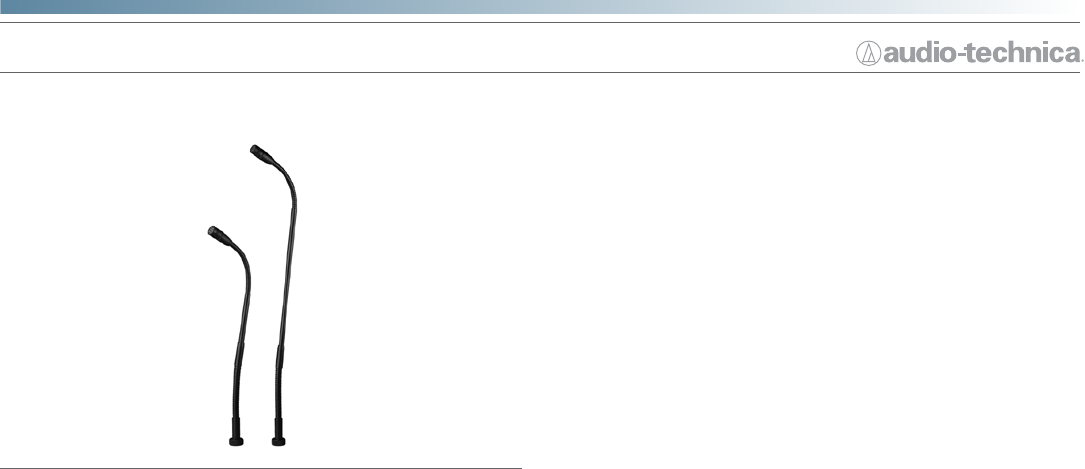
unipoint
®
microphones
Cardioid Condenser Adapter-Mount Gooseneck Microphones
U857R & U857RL
Features
• Direct mounts to any
5
/8"-27 stand, or to included threaded
mounting ange
• Low-prole element provides uniform cardioid polar pattern
with 120º acceptance angle
• Superior off-axis rejection for maximum gain before feedback
• UniGuard
®
RFI-shielding technology offers outstanding rejection
of radio frequency interference (RFI)
• Easy-to-adjust, rugged, small-diameter, alternating gooseneck
with virtually no “memory” permits quick positioning into
desired shape
• UniSteep
®
lter provides a steep low-frequency attenuation to
improve sound pickup without affecting voice quality
• Available interchangeable elements permit angle of acceptance
from 90° to 360°
Description
The U857R is a wide-range condenser microphone with a cardioid polar
pattern. It is designed for quality sound reinforcement, professional
recording, television and other demanding sound pickup applications.
The small-diameter double gooseneck design permits highly exible
positioning while maintaining a smooth, well-contoured appearance.
The U857R stands 305.0 mm (12.01") from the table or podium; it is also
available in a 421.0 mm (16.58") version as U857RL. The two models are
identical in all other respects.
The microphone requires 11V to 52V phantom power for operation.
The microphone is equipped with UniGuard
®
RFI-shielding technology,
which offers outstanding rejection of radio frequency interference (RFI).
The microphone’s cardioid polar pattern provides a 120° angle of
acceptance. Additional interchangeable elements with omnidirectional
(360°), hypercardioid (100°) and UniLine
®
(90°) pickup patterns are
available.
The microphone includes a 3 m (9.8') permanently attached miniature
cable. Its free end connects to the provided AT8538 power module via
a special TA3F-type connector designed to optimize RFI immunity. The
output of the power module is a 3-pin XLRM-type connector.
A recessed switch in the power module permits choice of at response
or low-frequency roll-off (via integral 80 Hz high-pass UniSteep
®
lter) to
help control undesired ambient noise.
The microphone comes equipped with a power module, a mounting
ange, a cable pass-through adapter and a two-stage foam windscreen.
The microphone is enclosed in a rugged housing with a low-reectance
black nish.
Installation and Operation
The U857R requires 11V to 52V phantom power for operation.
Output is low impedance (Lo-Z) balanced. The signal appears across Pins
2 and 3; Pin 1 is ground (shield). Output phase is “Pin 2 hot”— positive
acoustic pressure produces positive voltage at Pin 2.
The provided two-stage foam windscreen simply slips over the head of
the microphone, effectively reducing wind noise or popping.
An integral 80 Hz high-pass UniSteep
®
lter provides easy switching
from a at frequency response to a low-end roll-off. The roll-off position
reduces the microphone’s sensitivity to popping in close vocal use. It
also reduces the pickup of low-frequency ambient noise (such as trafc,
air-handling systems, etc.), room reverberation and mechanically coupled
vibrations. To engage the UniSteep
®
lter, use the end tip of a paperclip or
other small pointed instrument to slide the switch toward the “bent” line.
Cable exit is from the bottom of the microphone. The included pass-
through adapter, designed for use with desk stands and microphone
stands, provides a side-exit for the cable.
Avoid leaving the microphone in the open sun or in areas where
temperatures exceed 110° F (43° C) for extended periods. Extremely high
humidity should also be avoided.
Note: Audio-Technica has developed a special RFI-shielding mechanism,
which is an integral part of the connectors in the UniPoint
®
line. If you
remove or replace the connector, you may adversely affect the unit's
RFI immunity. Audio-Technica offers a crimp tool (ATCT) and RFI shields
that enable you to shorten the cable and correctly reinstall the connector
while maintaining the highest level of RFI immunity.
Architect’s and Engineer’s Specications
The microphone shall be a xed-charge condenser designed for
permanent installation or portable applications. It shall have a cardioid
polar pattern with a uniform 120° angle of acceptance and a frequency
response of 30 Hz to 20,000 Hz. It shall be capable of accepting
optional interchangeable elements for additional polar patterns. The
microphone shall operate from an external 11V to 52V DC phantom
power source. It shall be capable of handling sound input levels up to
139 dB with a dynamic range of 115 dB. Nominal open-circuit output
voltage shall be 11.2 mV at 1V, 1 Pascal. Output shall be low impedance
balanced (250 ohms). It shall offer outstanding rejection of radio
frequency interference (RFI).
The microphone shall have a 3 m (9.8') permanently attached miniature
cable, terminating in a special TA3F-type output connector designed
to optimize RFI immunity. The output connector shall connect to a
TB3M-type jack on the included power module. The power module shall
contain a recessed switch to permit choice of at response or 80 Hz
low-frequency roll-off. The output of the power module shall be a 3-pin
XLRM-type connector.
A
5
/8"-27 threaded ange shall be provided for permanent installation to a
mounting surface. An included pass-through adapter shall provide a side-
exit for the cable. A two-stage foam windscreen shall also be included.
The microphone shall be a small-diameter alternating gooseneck design,
with an overall length of 305.0 mm (12.01") [421.0 mm (16.58")] and a
head diameter of 12.2 mm (0.48"). Weight shall be 124 grams (4.4 oz)
